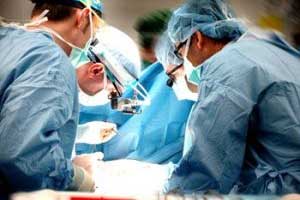- Home
- Editorial
- News
- Practice Guidelines
- Anesthesiology Guidelines
- Cancer Guidelines
- Cardiac Sciences Guidelines
- Critical Care Guidelines
- Dentistry Guidelines
- Dermatology Guidelines
- Diabetes and Endo Guidelines
- Diagnostics Guidelines
- ENT Guidelines
- Featured Practice Guidelines
- Gastroenterology Guidelines
- Geriatrics Guidelines
- Medicine Guidelines
- Nephrology Guidelines
- Neurosciences Guidelines
- Obs and Gynae Guidelines
- Ophthalmology Guidelines
- Orthopaedics Guidelines
- Paediatrics Guidelines
- Psychiatry Guidelines
- Pulmonology Guidelines
- Radiology Guidelines
- Surgery Guidelines
- Urology Guidelines
Surgeons for the first time perform heart surgery using 3D goggles

Surgeons at Poland have used 3D goggles while performing heart surgery. The real-time imaging technique uses ultrasound that collects 3D image and sends it to the 3D goggles so that the surgeon is able to actually see in 3D rather than looking at a 2D image projected on a flat screen. The technique was reported in the European Heart Journal.
Image-guided surgery is any surgical procedure where the surgeon uses tools conjugated with preoperative or intraoperative images to directly or indirectly guide the procedure. This technology is extensively used by laparoscopic surgeons.
One of the major drawbacks of conventional laparoscopic surgery is lack of depth perception due to the planer image from two-dimensional monitors. Therefore periodic tapping of internal surfaces is required to get oriented. With the ability to see in three dimensions, the surgeon using the new technique was able to orient himself without having to tap instruments against the heart, the authors note.
“We developed the method of real-time streaming of (ultrasound) data into head-mounted mixed-reality holographic display allowing for touchless control and data sharing within the cath-lab,” the research team led by Jaroslaw Kasprzak, a cardiologist at Bieganski Hospital and chair in the department of cardiology at the Medical University of Lodz writes. “The method was tested for the first time in a human during (a procedure to widen the mitral valve).”
During that procedure, a deflated balloon is placed inside the narrowed valve and then inflated to widen the opening so blood will flow more freely, explained Dr. Omar Ali, director of the cardiac catheterization lab at Detroit Medical Center’s Heart Hospital in Michigan. Ali was not involved with the new research.
“I do minimally-invasive structural heart procedures, such as fixing the valves in the heart,” Ali said. “We usually rely on 3D ultrasound images of the heart that are projected onto a flat screen.”

Disclaimer: This site is primarily intended for healthcare professionals. Any content/information on this website does not replace the advice of medical and/or health professionals and should not be construed as medical/diagnostic advice/endorsement or prescription. Use of this site is subject to our terms of use, privacy policy, advertisement policy. © 2020 Minerva Medical Treatment Pvt Ltd